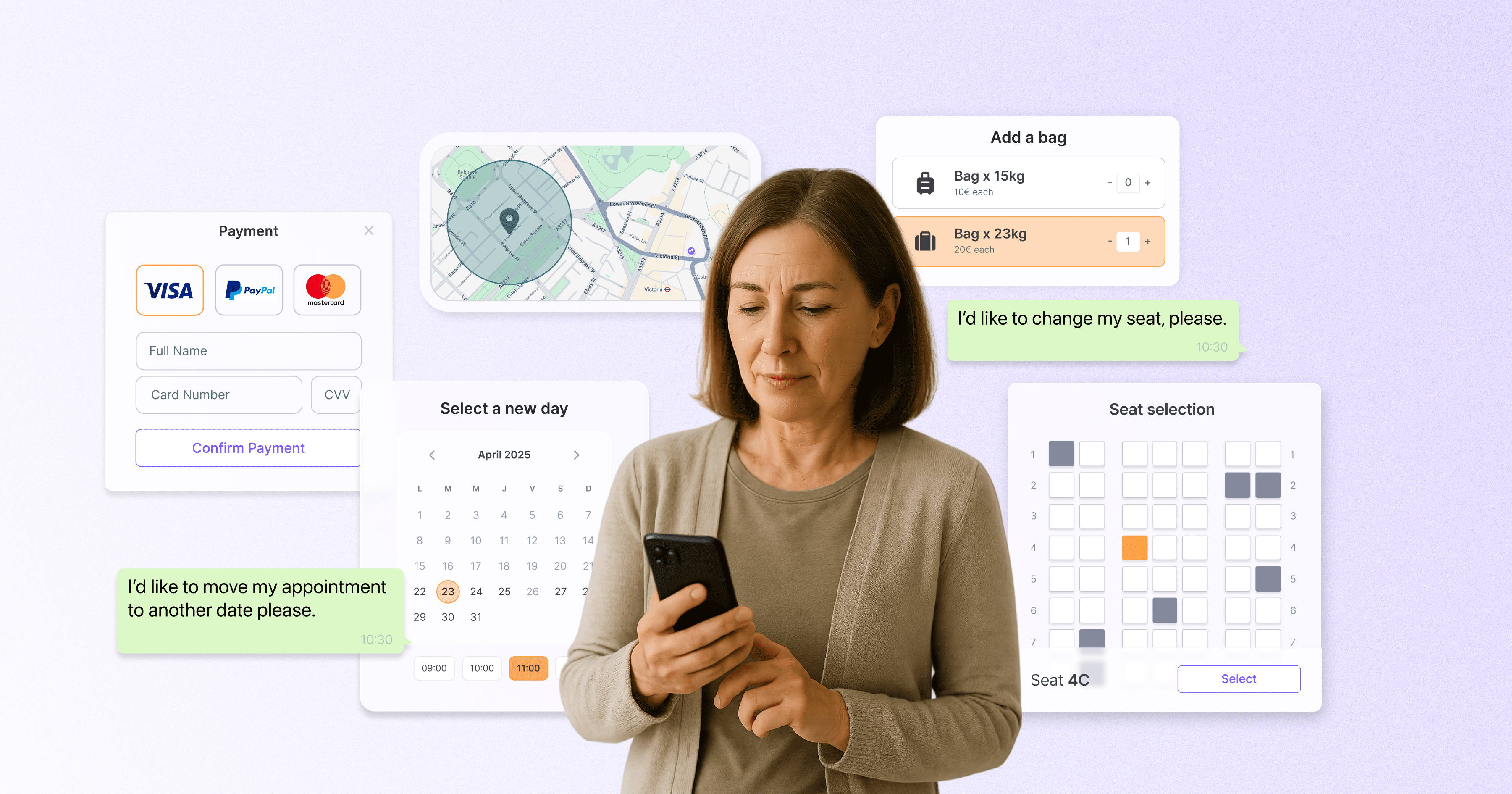Contact centre automation solutions help scale and improve customer experiences. Right now, contact centres are facing higher call volumes, new pressures, and changing work-from-home situations. Thankfully, automation is helping them adapt and meet these new demands.
What is contact centre automation?
Contact centre automation describes a wide range of technologies that reduce human intervention in contact centre processes. It increases efficiency, reduces costs, improves accuracy, and frees up human resources for higher-value work.
Though, the goal of contact centre automation is not only to improve efficiency. Instead, it’s a key tool in improving customer experiences.
Benefits of contact centre automation
There are many benefits of contact centre automation. Below are 5 of the top business benefits and areas of impact.
1. Drives operational efficiency
- Reduces average handle time (AHT)
- Reduces time to resolution
- Improves first contact resolutions
2. Helps managers meet service level agreements (SLAs)
- Improves average speed of answer
- Reduces abandon rates
- Provides better insights and SLA tracking
3. Improves customer satisfaction
- Faster response times
- Reduces average time in queue
- More self-service options
- More contextual experiences
4. Improves agent satisfaction and reduces employee turnover
- Reduces repetitive and mundane tasks
- Encourages creative problem solving
- Frees up humans for higher-value work
5. Drives customer loyalty and revenue
- Decreases customer churn
- Reduces customer acquisition costs
- Improves net promoter scores
Why is contact centre automation important?
Contact centre automation is no longer a “nice to have.” Customer expectations are at an all-time high, making the customer experience more important than ever.
As a result, contact centres are getting a well-deserved promotion from cost centre to profit driver. Business leaders recognise that to deliver true omnichannel customer support and service, they must empower their contact centre teams and give them the tools they need for success.
1. Customer expectations are at an all-time high
- 90% of Americans use customer service as a factor in deciding whether or not to do business with a company.
- 58% of American consumers will switch companies because of poor customer service.
- 63% of consumers expect businesses to know their unique needs and expectations, while 76% of B2B buyers expect the same thing.
- Roughly 54% of customers say they would switch to a new brand after one bad experience.
2. Contact centres face new pressures as customer experience takes centre stage
With customer experience in the spotlight, business leaders are increasing the pressure on contact centres. The expectations of their customers are rising, so it’s only natural that their expectations for contact centres are rising too.
In addition, business leaders are taking a hard look at key success metrics. They’re placing a greater emphasis on metrics related to customer satisfaction, as opposed to just those related to operational efficiency.
3. Contact centres are adapting to lasting shifts in customer and employee expectations
Customer service demands surged during the pandemic and they haven’t slowed down. Contact centres continue to manage high volumes of inquiries, shifting customer behaviours and evolving workforce expectations.
Automation is playing a critical role in helping teams scale without constant hiring. It allows businesses to manage demand more efficiently, while also supporting hybrid and remote work models that prioritise flexibility and employee well-being.
By streamlining workflows and reducing repetitive tasks, automation is improving operational resilience, enabling faster response times, and helping contact centres retain talent in an increasingly competitive job market.
Contact centre automation use cases
So, we’ve got changing customer expectations and an increasing demand for digitisation and efficiency in customer communications. What does that really look like? Here are some use cases where contact centre automation comes in handy:
- Self-service options: allowing customers to resolve common issues independently through chatbots, knowledge bases, messaging channels like WhatsApp automation or phone IVR deflection to WhatsApp.
- Personalised customer experiences: leveraging AI to analyse customer data and provide tailored support or product recommendations.
- Automated follow-ups: sending post-interaction surveys, emails, or texts to gather feedback, confirm resolutions, or upsell services. Have a look at this success story and learn how easyJet boosted its Trustpilot score by 107% in just 3 months, a great example of the benefits a single automation can bring.
- Real-time support assistance: helping agents with AI-powered tools that provide suggested responses, recommended actions, or even real-time sentiment analysis during live interactions.
- 24/7 customer support: offering round-the-clock availability through virtual assistants and automated systems.
- Sentiment analysis: monitoring conversations for customer mood or satisfaction levels, helping prioritise escalations or improve service quality, fundamental for businesses looking to implement a Voice of the Customer strategy.

Contact centre automation tools
Conversational applications
Contact centre leaders use conversational apps to orchestrate contextually relevant experiences across complex journeys. Conversational apps are custom solutions that integrate with your tech stack, communication channels, and other tools that you use to keep your contact centre running smoothly.
Companies use conversational apps to build branded experiences inside of the channels that their customers already use (like WhatsApp, Facebook Messenger, and Telegram). With them, businesses can build rich, multimedia experiences to help customers buy products, return items, get technical support, or do anything else they would normally do on a traditional app or website.
Essentially, conversational apps serve as hubs for omnichannel communication. They provide an important framework for contact centres to deploy chatbots, automate workflows, and use the rest of the tools on our list effectively.
Chatbots
We know chatbots have a bad reputation. But they’ve come a long way since they first came on the scene. Today, good chatbots are more like smart conversational agents. They can recognise intent, add context, and make experiences more valuable (instead of more frustrating).
In fact, modern customer service chatbots can predict customers’ needs based on their past conversations, purchases, or browsing behaviours. They can cross-sell and upsell products, solve issues faster, and generally make customers happier.
Chatbots integrate with conversational applications, CRMs, and other tools. They can fetch information from a database with customer or account information. For example, your call centre chatbot can help track a shipment, send order confirmations, and much more.
Cloud-native automation
As the number of customer communication channels increases, it becomes harder for agents to manage. They must sort through multiple data sources and systems before they have the information they need to respond.
Cloud-native automation connects data and automates manual processes, empowering agents to solve problems faster. Instead of scrambling to find account details and order history, cloud-native automation helps agents access the information that they need quickly.
Real-time transcription
Though many contact centres are trying to steer customers towards digital channels, the phone still remains an important part of doing business. Real-time transcription gives contact centres more insight into if those phone calls are successful, and how they can be improved.
Real-time transcription turns voice calls into text transcription, which makes it possible to use analytics and other tools to look for patterns in the data.
Robotic process automation
Forrester defines robotic process automation (RPA) as a tactical, short-term fix to digitise common, reproducible agent tasks in the contact centre. It’s an easy overlay to your existing technology ecosystem and extends the life of the contact centre applications.
There are two forms of RPA:
- Attended RPA is defined by human-bot collaboration. They are like virtual assistants, helping an individual employee with their tasks to boost productivity.
- Unattended RPA runs independently, scheduling back-office tasks, such as claims processing or generating invoices, from a work queue.
Essentially, RPA helps automate mundane, manual processes (like data entry). This allows the agents and employees to focus on their core competencies and work to make experiences better.
Contact centre automation best practices: scale and improve customer experiences
Here’s a short list of fundamentals to pay attention to if you’re looking at how to implement contact centre automation:
1. Go digital-first and human when it matters
The evolution of digital channels has made life easier for both call centres and customers. Immediate, always-on service via native channels is a win-win. However, it’s important to remember that while a digital-first approach is important, it’s also critical to include a human touch where it matters.
The goal of contact centre automation should be to make human interactions more meaningful, not to eliminate them.
2. Prioritise metrics related to customer experience
We know that customer experience is key to success. The more you can understand the relationship between operational metrics and customer experience metrics, the better.
Ultimately, the metrics listed below will be key indicators of success:
- Customer Effort Score (CES)
- Customer Satisfaction (CSAT)
- Net Promoter Score (NPS)
- Customer Retention Rate
- Customer Churn Rate
- First Contact Resolution (FCR)
- Customer Referral Rate
3. Make sure you have the right technological foundation
Without a doubt, technology can make or break a modern call centre. You’ll need to adapt and try new software to stay ahead of the curve. However, it’s critical that you have the right framework to build on top of.
A cloud-based conversational platform is a good foundation for future success. It will serve as the hub from which you can connect new tools, adapt, and deploy new conversational experiences.
If you are lacking the right technological framework, now is the time to correct it in order to avoid even more long-term challenges.
4. Support and motivate agents
The idea of contact centre automation can be daunting for employees. Many assume that they will soon be replaced by robots and artificial intelligence.
For that reason, it’s important to share your goals with employees. Namely, that automation is here to help empower them to make deeper connections and focus on what they do best.
5. Use data to better understand customers
Lastly, it can be easy to run with assumptions of what customers want and need. As you embrace contact centre automation, it’s important to embrace new data for better decision-making.
What customers expect will likely differ depending on the channel, business, and stage of the customer lifecycle. So, make sure you segment your data appropriately for more actionable information.
Contact centre automation companies
At Hubtype, we know that managing a contact centre is complex, as is the technology that’s needed to make it run well. Our conversational platform is built to address the challenges of modern contact centres, automate conversations meaningfully, and make customer experiences better.
Book a demo to find out more about Hubtype and how our technology sets contact centres up to compete in a rapidly changing world.









.jpg)


